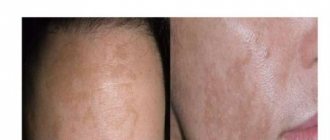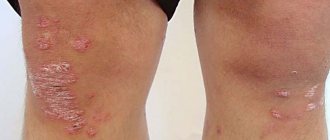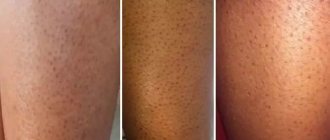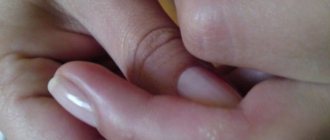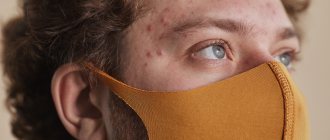The skin is a protective organ of a person, which not only performs its assigned functions, but also reflects the condition of the entire organism as a whole. Any changes in the condition of the skin may indicate the presence of negative external influences, or the development of serious diseases.
Red spots on the legs are pronounced changes in the color of the dermatological integument that appear in one area of the skin. The cause of the appearance of this defect on the limbs can be both cosmetics and pathological changes that occur inside the body.
If the disease is not treated, then after some time it will begin to slow down all metabolic processes and this will immediately affect the formation and functioning of pigment cells. If their work is disrupted sufficiently, unsightly spots begin to appear on the skin.
Causes of dark rashes
A dark spot on the lower leg on the legs of men or women is not only a cosmetic defect, but also a sign of pathological processes in the body. Such rashes differ in color, size, structure (smooth or flaky), as well as the causes of their occurrence. Conditions that can cause dark spots on the shins include:
| Disease | Characteristic symptoms |
| Varicose veins | Reddish-brown spots of varying sizes and irregular shapes |
| Chronic dermatitis | Dark brown spots of small to medium size, itchy and flaky |
| Diabetes | Dark or light brown rashes, varying in size |
| Atherosclerosis | Dark spots that are small in size and symmetrically located |
| Neurofibromatosis | Numerous small spots of brown-milky color |
| Liver cirrhosis and fibrosis | Brownish-yellowish or pinkish rashes that are round or oval in shape |
| Psoriasis, ringworm and eczema | Darkened areas of the legs become rough, itchy and flaky |
| Lentigo | Itchy brown or dark brown spots that appear in large numbers |
Darkened spots on the skin of the legs and other parts of the legs can appear as a result of a malfunction of the thyroid gland and the entire endocrine system, metabolic disorders and vitamin deficiency.
Dark spots in women and men
The causes of dark rashes on the legs may differ between men and women. Dark, almost black spots with clearly defined boundaries may indicate the development of chloasma.
This is a pathology that is accompanied by excessive accumulation of melanin in one area of the skin, which leads to hyperpigmentation.
Chloasma occurs only in women - and spots can appear not only on the legs, but also on the chest around the nipples, stomach, and face.
Skin pigmentation in men can be caused by Becker's melanosis. Most often, such spots appear at a young age and look like ordinary moles. Hair growth accelerates in darkened areas. The exact cause of the development of Becker's melanosis has not been established.
At the initial stage of development, the rashes have a light beige, pinkish tint. As they progress, they acquire a rich brown, almost black tint. Blackening of the skin indicates the onset of tissue necrosis. In such cases, emergency surgical intervention is required, otherwise gangrene may develop.
Mechanical
Small red dots on the leg
The presented group is the safest for human life and health. In this case, provoking factors can be easily eliminated on your own. Speaking about external reasons, it should be noted:
- Wearing clothes made of synthetic materials. Such fibers can irritate the skin, for example, very tight tights, jeans, trousers lead to disruption of normal blood circulation and air penetration.
- Wrong shoes. Wearing a tight or uncomfortable pair of shoes can lead to the formation of corns, calluses, and red, painful spots.
- Epilation. If your skin has a low level of sensitivity and the capillaries are located deep, then nothing will happen. Otherwise, multiple red rashes may be observed.
- Insect bites. If this happens, then most likely the bite site will be very itchy, which leads to the formation of microcracks, which are the entrance gate for the attachment of pathogenic bacteria.
As for treatment, in each of the presented cases it is very simple. It is enough to exclude contact of the skin with the irritant, and after a few days the stain will simply disappear. If the rash is associated with an insect bite or depilation, then you can lubricate the affected area with Fenistil or Minovazin.
Impact of external factors
If a dark spot appears on the lower leg, this can be caused by completely natural, harmless factors.
- wearing uncomfortable, tight shoes;
- tight, constricting clothing that causes discomfort;
- improper epilation or shaving;
- allergic reaction to cosmetics and medications, as well as hygiene products;
- tanning in a solarium;
- allergy to self-tanning products;
- deficiency of vitamins in the diet;
- injuries, bruises and abrasions;
- changes in hormonal levels (during menstruation, menopause or pregnancy);
- age-related changes in the body;
- hereditary predisposition.
Dotted spots can be ordinary freckles and occur in a person of any age, both an adult and a child. They do not require drug treatment and should not cause concern.
In women, hyperpigmentation is most often observed during pregnancy.
The appearance of beige-brown rashes on the skin of the legs or other parts of the body is associated with hormonal “changes” in the body. They do not require special treatment and disappear on their own after the birth of the child.
Features of varicose veins
In the absence of timely treatment, varicose veins lead to dangerous consequences, one of which is reddish-brown, blue or brownish-brown spots on the lower leg. They arise along the veins - both in front and behind.
The main types of vascular spots:
- Inflammatory
- develop against the background of capillary expansion over a long period of time. - Edema
- such dark spots most often appear as a result of short-term dilation of blood vessels under the influence of environmental factors. This could be a bruise, burn or other stress to the skin. - Hemorrhagic
- rashes develop as a result of increased permeability of blood vessels. They may indicate concurrent problems with the cardiovascular system.
Increased pigmentation of the skin of the legs can also be a concern after surgical removal of veins - sclerotherapy or phlebectomy. The rash is accompanied by additional symptoms - swelling of the ankle joint, loss of sensation in the limb. In case of such complications, a repeated visit to the surgeon is required.
Infections
Spots due to erysipelas
It often happens that the skin below the lower leg becomes covered with spots. This can happen with the progression of erysipelas, which occurs when the body’s protective function decreases. You can suspect the disease by the nature of the spots: they are red, with clear edges on which a ridge forms. Body temperature rises significantly, swelling, itching and pain appear. When the process is neglected, the skin peels off, and blisters form in these places, developing into ulcers that heal poorly.
To stop the inflammatory process, as well as normalize body temperature, it is recommended to take medications with antipyretic and anti-inflammatory effects (NSAIDs). The most accessible remedy would be Paracetamol. Nurofen and Ibuprofen also help well, and the complex should be supplemented with agents that suppress the activity of pathogenic bacteria, for example, Erythromycin or Ampicillin.
In the absence of damage to the skin, it is recommended to give preference to topical preparations. But it is better that all medications are prescribed by a doctor.
Dark spots due to dermatological diseases
Dark rashes on the shins and other parts of the legs can be caused by various dermatological diseases. These include:
- eczema;
- psoriasis;
- lichen;
- neurodermatitis;
- dermatitis.
Eczema develops against the background of disturbances in the functioning of the endocrine and nervous systems, allergies or slow metabolism. Rashes on the legs are associated with varicose eczema, which is accompanied by circulatory disorders and blood stagnation.
Most often, spots appear on the lower legs, accompanied by redness, peeling and itching.
The cause of the rash can be pityriasis versicolor - with other types of the disease the rash is red. In most cases, it appears on the upper half of the body, but sometimes it can occur on the legs.
No less often, brown spots on the legs appear with psoriasis, dermatitis, neurodermatitis or allergies. Treatment is selected depending on the disease that caused the rash. In the case of neurofibromatosis, rashes on the legs have a different color, location and area of damage. Only a dermatologist can make an accurate diagnosis after an examination.
Diagnostics
If itchy red spots appear on your legs, you should consult a dermatologist. Before visiting a specialist, you do not need to smear the rash with brilliant green or iodine, as this may complicate diagnosis.
To begin with, an initial survey of the patient is carried out, during which he talks about when the spots began to appear, what preceded this and what accompanying symptoms they are accompanied by. Next, dermatoscopy is performed - examination of the affected areas of the skin using a special medical instrument - a dermatoscope.
If necessary, a tissue sample is taken from the surface of the rash for further microscopic examination. It allows you to determine the type of causative agent of a dermatological disease. Based on the results of such a test, the doctor can prescribe the most effective treatment.
If the red spots on the legs are not related to skin pathologies, the patient may be referred to other specialists:
- allergist;
- neurologist;
- endocrinologist;
- hematologist;
- cardiologist;
- oncologist.
Only on the basis of a comprehensive diagnosis will the doctor be able to prescribe correct and effective treatment.
For diabetes
The appearance of dark spots at the bottom or top of the lower leg is a frequent “companion” of diabetes mellitus. With this disease, the skin of the legs becomes hypersensitive, which leads to increased hyperpigmentation. Most often, such rashes are accompanied by itching, burning, discomfort and unpleasant, painful sensations.
Darkened or reddened spots in diabetes mellitus may indicate necrobiosis.
Such rashes are large in size; in the middle you can see an atrophied area of skin. This process is considered irreversible; in such cases, only symptomatic therapy is prescribed.
One of the most dangerous complications of diabetes is the appearance of trophic ulcers on the skin of the legs. In such cases, treatment methods are selected on an individual basis, most often surgical intervention is performed. After surgery, it is necessary to regularly treat the skin of the legs with special medications - for example, Actovegin.
Types of urticaria
There are several classifications of urticaria.
1. By time:
- acute – lasts up to 6 weeks;
- chronic – more than 6 weeks.
2. By nature:
- allergic (immune) - realized through the development of an immune reaction, often combined with other allergic diseases (bronchial asthma, rhinitis, conjunctivitis, dermatitis, etc.);
- non-allergic - through the direct release of histamine.
3. Due to:
— allergic urticaria
may cause:
- Food;
- taking medications;
- insect allergens (insect allergy);
- pollen allergens.
— non-allergic
form of the disease occurs due to a direct effect on the mast cell:
- physical factors - such as cold, heat, ultraviolet radiation, radiation, vibration, compression;
- chemical (provoking factors are solvents, acids, alkalis and other chemicals);
- certain medicines, such as aspirin;
- infectious agents - viruses (adenoviruses, Epstein-Bar virus, enteroviruses), streptococci, helminths, Helicobacter pylori;
- for systemic and other chronic diseases (rheumatoid arthritis, systemic lupus erythematosus);
- with a sharp increase in the level of histamine and other active substances in the blood due to the large consumption of foods high in them: eggplants, canned food, nuts, bananas, chocolate and others.
Hereditary, psychogenic, and idiopathic urticaria (this is the name for a disease whose cause has not been established) is also possible.
The wide variety of factors and similar developmental mechanisms of individual species make it difficult to find the cause. Most often, this requires the help of a specialist.
For atherosclerosis
Darkened spots on the skin of the legs may indicate the development of atherosclerosis. This disease occurs against the background of blockage of the blood vessels of the lower extremities with atherosclerotic plaques.
This disease is characterized by symmetrically located small rashes, the size of which does not exceed 2 cm. As atherosclerosis progresses, the spots noticeably increase in size. The appearance of spots on the legs is combined with other symptoms of atherosclerosis:
- fatigue during walking and physical activity;
- lameness when putting weight on the legs;
- cramps, numbness and a feeling of “pins and needles” in the legs;
- exhaustion and weight loss of the lower extremities;
- muscle fiber atrophy;
- long-term healing of scratches, wounds and injuries.
The severity of symptoms in atherosclerosis depends on aggravating factors, which include smoking, diabetes, and old age. Atherosclerosis requires urgent treatment, as this disease can cause many serious complications, including septic conditions, gangrene and the need for limb amputation.
Red, rough spots on the legs: what to do?
Rough patches on the skin can result from atopic dermatitis.
- If you know for sure that the appearance of red spots was caused by cosmetics or detergents, then simply eliminate the source of irritation and use hygiene products without fragrances and dyes to care for your limbs for a couple of days
- If everything is in order with your body, then after 3-4 days the skin will return to its normal color and you will again be able to feel confident in public.
- But if the spots do not disappear, and their foci only increase in size, then you need to seek help from a specialist
- Usually such patients are offered to undergo venography and, of course, a complete examination of the whole body. If any pathology of internal organs is found, further treatment will be carried out comprehensively
- The doctor will select remedies that will help fight both one and the other pathologies at the same time. If for some reason you cannot quickly see a doctor, then try to alleviate your condition with antihistamines and ointments that have anti-inflammatory properties
Changes in skin color due to hyperpigmentation
In most cases, darkening of the skin of the legs is associated with hyperpigmentation. They occur in men and women over 45-55 years of age and are called age-related. Such spots can have different color saturation, size and shape. Most often, age-related pigmentation intensifies under the influence of ultraviolet radiation.
Age-related pigmentation of the skin of the legs does not require any treatment and does not cause pain or discomfort; the only concern that age spots can cause is the unsightly appearance of the legs. Age-related hyperpigmentation must be distinguished from carcinoma. This is a malignant disease that affects the tissues of the skin, mucous membranes, and various internal organs. The greatest danger is caused by spots located in the lower parts of the lower leg and rapidly increasing in size. With carcinoma, the darkened areas of the body become rough, and compactions gradually form on their surface. If such neoplasms are detected, you should immediately contact an oncologist to clarify the diagnosis.
For liver diseases
The appearance of dark spots on the legs can be caused by hepatitis or cirrhosis of the liver. Also, rashes on the legs are characteristic of cholangitis, cholecystitis, cholelithiasis, liver failure, malignant tumors or helminthic lesions of the liver.
The liver plays the role of a kind of filter in the body, removing toxins and toxic substances. When its functioning is disrupted, toxins begin to accumulate, which leads to the formation of dark spots.
Rashes on the legs due to liver diseases can be identified by a characteristic brownish-yellowish or pinkish tint.
Most often they are round or slightly oblong, flat, arranged in a chaotic manner. Such spots are accompanied by severe itching and burning, causing serious discomfort. Liver diseases have other, additional symptoms - redness of the skin of the palms, yellowing of the sclera, the appearance of a pink rash in the abdomen and white plaque on the tongue, small vascular networks on the face, upper or lower extremities.
Diagnostic procedures for urticaria
Diagnosis of acute urticaria is usually quite simple. An examination and questioning of the patient about his medical history is sufficient. Finding out the reason is not so easy, and for this purpose additional research is carried out:
1. Laboratory tests:
- general blood and urine analysis;
- blood biochemistry (liver tests - ALT, AST, bilirubin, rheumatic tests, blood glucose);
- stool examination (coprogram);
- bacterial cultures from the nasal and pharyngeal mucosa.
2. Instrumental research:
- chest x-ray;
- Ultrasound of the abdominal organs;
- endoscopic examinations of the upper and lower gastrointestinal tract (gastroscopy, colonoscopy).
3. Allergy tests:
- intradermal tests with allergens;
- cold and heat tests;
- physical stress tests, line drawing, tourniquet application.
4. Immunological methods.
5. Consultations of related specialists:
- gastroenterologist;
- endocrinologist;
- rheumatologist;
- gynecologist and others as necessary.
First of all, it is important for a specialist to establish what nature the urticaria is – allergic or non-allergic. In the allergic form, one can clearly trace the connection between the symptoms and the introduction of the allergen. It is confirmed by skin, allergy and immunological tests.
